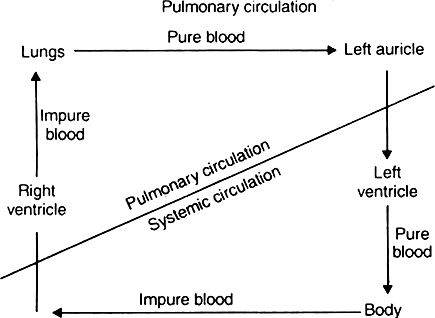
Define a cardiac cycle and the cardiac output.
Name the components of the formed elements in the blood and mention one major function of each of them.
Blood contains formed elements. Erythrocytes, leucocytes, and platelets are collectively known as formed elements.
i. Erythrocytes - They are also called Red Blood Corpuscles (RBCs). They are the most abundant elements present in the blood. RBCs are formed in the red bone marrow in the adults. They are devoid of a nucleus.
Their main function is the transport of the respiratory gases.
ii. Leucocytes - They are also called White Blood Corpuscles (WBCs). They are nucleated and less abundant as compared to the RBCs. The WBCs are further divided into granulocytes and agranulocytes. The granulocytes are of three types neutrophils, eosinophils and basophils. Monocytes and lymphocytes constitute the agranulocytes. The lymphocytes are further
The main function is to provide immunity to the body against the pathogenic organisms.
iii. Platelets - They are also known as thrombocytes. Platelets are small irregular bodies present in the blood. They contain essential chemicals that help in clotting.
The main function of platelets is to promote clotting.
What is meant by double circulation ? What is its significance ?
Double circulation of blood : In double blood circulation, first impure blood comes to the heart and then it is supplied to the lungs for purification. Then pure blood is collected and poured into heart and it is supplied to all the parts of the body. Double circulation comprises two types of circulation as :
1. Pulmonary circulation : It is the circulation in which impure blood from rt. ventricle of heart goes to lungs and after purification it is poured back into the heart (left auricle).
Significance : Due to it blood is purified.

Right auricle Fig. Double circulation of blood in mammals
2. Systemic circulation : It is the circulation in which pure blood from left ven heart is pumped to all the parts of the body and then impure blood is collected and poured into right auricle.
What is the importance of the plasma proteins?
Plasma proteins constitute 6-8% of the plasma. Fibrinogen, globulins, and albumins are the major proteins of the plasma.
Following are the importance of the plasma proteins:
i. Fibrinogens - these are required for the clotting and coagulation of the blood.
ii. Globulins - these are involved in the defence mechanism.
iii. Albumins are required for maintaining the osmotic balance.
What is the significance of atrio-ventricular node and atrio-ventricular bundle in the functioning of heart?
The atrioventricular (AV) node is present in the right atrium, near the base of the inter-auricular septum that separates the right auricle from the ventricle. It gives rise to the bundle of His. The Bundle of HIS conducts the cardiac impulses from the auricles to the ventricles. As the bundle of His passes the ventricle along the inter-ventricular septum, it divides into two branches - the right ventricle and the left ventricle.
The end branches of this conducting system then forms a network of Purkinje fibres that penetrate into the myocardium. The auricular contraction initiated by the wave of excitation from the sino-atrial node (SA node) stimulates the atrio-ventricular node, thereby leading to the contraction of ventricles through the bundle of His and Purkinje fibres. Hence, the atrio-ventricular node and the atrioventricular bundle play a role in the contraction of ventricles.
